[ad_1]
The Texas Cichlid is a fresh water aquarium fish that is native to the United States. Scientifically, it is referred to as the Herichthys cyanoguttatus while it is also sometimes called the Rio Grande Perch. It is such a highly aggressive fish that should ideally be kept alone in the tank or other hard-line fish species of similar size but in a bigger tank. The tank should be at least 125 gallons or more because it is generally a large fish.
This should not be your choice of aquatic freshwater fish if you are not keen on dealing with belligerent type of fish species. Basically, the best way to keep the fish species is to put a male and female in a tank of 125 gallons. Just be sure to be ready to separate the fish if you notice any sign of incompatibility between the pair though. Better still you can use a good material to divide the tank into two sections for the male and for the female sections.
Texas Cichlid Overview
In the scientific community, the Texas Cichlid is called Herichthys cyanoguttatus. It belongs to the renowned Cichlidae family and is among the most well-known. The name comes from the fact that this variety is indigenous to Rio Grande Drainage, situated in the United States.
Cichlids from Texas and Central America are aggressive and territorial. As a result, this species is the most dominant in its natural habitat. They can also be picky about tank mates and community tanks because of this feature.
| Information Chart | Texas Cichlids |
|---|---|
| Scientific Name: | Herichthys cyanoguttatus |
| Family: | Cichlidae |
| Care Level: | Moderate |
| Temperament: | Aggressive |
| Color: | Light blue |
| Lifespan: | 13 years |
| Size: | Up to 12 inches |
| Diet: | Omnivore |
| Minimum Tank Size: | 55 gallons |
| Temperature: | 71.5°F-77°F |
| Water Conditions: | pH: 6.5-8, Water hardness: 8-15 dGH |
| Tank Mate Compatibility | Semi-aggressive |
Texas Cichlids are popular among aquarium keepers for various reasons, one of which is their attractive appearance. This species comes in various colors, which adds to the fish tank’s beauty and elegance. Their significant economic importance and pleasant activities are two further factors.
Keeping Texas Cichlids in aquariums does, however, provide some difficulties. However, if you know the appropriate procedures, you can alleviate these difficulties. The Texas Cichlid Care Tips will assist you in taking care of your cichlids.
Appearance of Texas Cichlid
The overall appearance of the fish is generally bigger compared to other common species of fresh water aquarium fish. In terms of the color, well, the fish has got bright coloration something that makes it a favorite of some aquarists. It’s iridescent golden color featuring pearl highlights and white dots that adorn its body and fins makes it such a lovely fish to look at!
There also several spots of black that can be seen just at the base of the caudal fin of the fish on the rear half of the fish’s body. The juveniles of the fish exhibit iridescent pearl-gray body and also white dots on the fins and parts of the body. The juvenile fish are not overly aggressive as the full grown adult fish.
Distinguishing the male from the female may prove to be quite a challenge for you especially if you a beginner. Here below are some important attributes of the sexes that can help draw a distinction between each sex:
Because of their distinctive look, Texas Cichlids are easily distinguished from most other aquarium fish species. Their individuality extends from their size and color to their assertiveness and elegance in the water. Differentiating between female and male Texas Cichlids is often the most difficult task.
This kind of fish is known for growing to enormous proportions. Texas Cichlids can grow up to 12 inches in length, be kept in the right conditions, and be fed the right diet. They grow to be 10-13 inches long on average in the wild.
Texas Cichlids have a unique Cichlidae silhouette. They have a strong fin that sits sloppy and somewhat bent on the base of their fin. Their heads also have a noticeable hump.
Another distinguishing characteristic of Texas Cichlids is their color. The presence of these creatures in a fish tank may cause it to sparkle and emit lovely colors.
Individual fish colors vary somewhat, but they always have a distinctive dotted pattern. The dots are of varying sizes and are not arranged in any particular order. One of the most visible differences is the color of these dots, which can range from light blue to green.
Texas Cichlid juveniles have a pearly grey body with scattered white spots on the fins and a few other body parts. Similarly, two distinctive black dots can be found on their bodies, one near the base of the caudal fin and the other in the center.
Adult Texas Cichlids are also designated as Green Texas Cichlids, Blue Texas Cichlids, and Red Texas Cichlids, according to their distinguishing colors. These colors are usually found on the dotted spots, with gold, dark, or light blue as the backdrop body color. It’s worth noting that there’s a distinct color shift when they mature from juveniles to adults.
Texas Cichlids’ Lifespan
Texas Cichlids have a lengthy lifespan, which gives them an edge over most other species. They outlive most other aquarium fish.
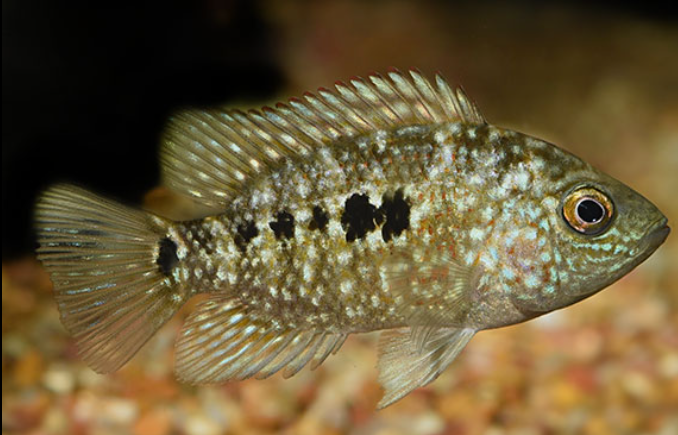
If kept under perfect and adequate conditions, Texas Cichlids can live for 13 years. This species lives in the wild for an average of 10 to 15 years.
However, it is important to remember that the longevity of this species fluctuates due to a variety of variables. When rearing this species in a tank, you have complete control over these variables.
Texas Cichlids’ lifespan in an aquarium is affected by several factors, including:
- Feeding
- The tank’s state
- Mates in the tank
External factors
Pests and parasites, whether present or not
The healthier and longer Texas Cichlids live, the more you improve these factors that favor them.
Texas Cichlids Size
The average Texas Cichlid measures roughly 12 inches in length when fully grown. These fish are highly imposing when combined with their powerful body. This species is normally only a few inches long when offered in stores. They do, however, have a high growth rate, so that they won’t stay this big for long!
Texas Cichlids Natural Habitat and Origin
Texas cichlids are unique to the lakes and rivers of south Texas and northern Mexico, rendering them the world’s most northern cichlid species. It’s also the sole cichlid that’s endemic to the US.
The natural habitat of the Texas Cichlid is the Southern United States and North East Mexico. It is considered the only cichlid fish species to appear naturally in the US without having been introduced there by humans.
It is a fresh water fish that will be found in fast flowing rivers and also in still waters such as ponds and lakes. Interestingly, it can easily dwell in neutral and slightly hard waters of pH between 7.5 and 9.0. The fish is also capable of adapting to big variations of temperatures thus making it easy to keep in a number of aquarium conditions.
The fish will easily live in both warm and cold waters something that has enabled it to expand to regions which were not originally its habitat. The fish is even being considered to be an invasive species for the fact that there are certain areas it has driven out common fish species.
Texas Cichlid Tank Size and Specifications
Taking good care of the Texas Cichlid will help them live longer, stay healthy, grow properly, and keep their lovely appearance. It can be disastrous to keep them in an improper tank or neglect them.
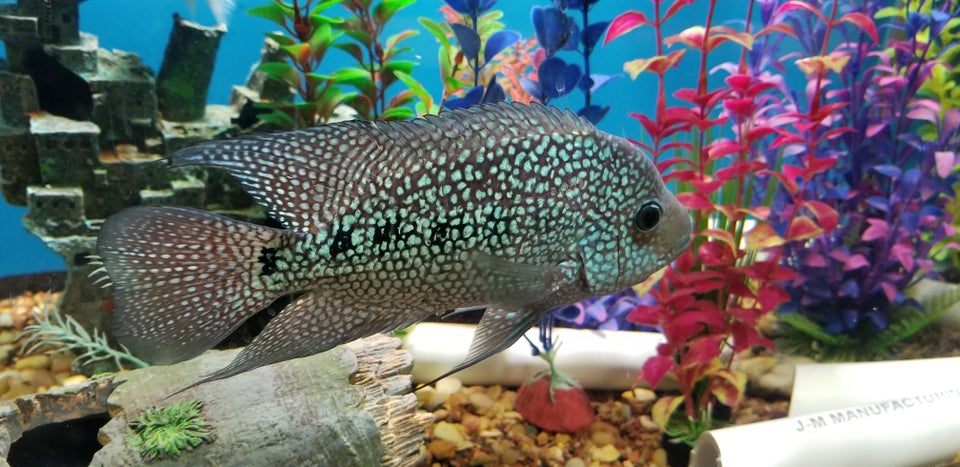
Texas cichlids are freshwater fish that can easily be re-created in your aquarium to mimic their natural environment. Simply evaluate essential environmental elements and tank characteristics like tank size, temperature, pH, and so on.
Substrates and sparse plants can be incorporated within the tank arrangement. This enhancement will aid in the most accurate representation of their native habitat.
To keep things as natural as possible, these substrates can be fine sands, gravel, or a mix of both. This simulation will benefit from the addition of artificial or live tanks. It will give the fish places to hide and rest, especially in juvenile tanks.
Optimum Tank Size of Texas Cichlids
When it concerns tank size, Texas Cichlids require a lot of room to swim and move about. Apart from the fact that they can grow rather large, they are also aggressive and territorial.
You’ll need 45–55 gallons of water for every fish on average. Because Texas Cichlids are quick, you may want to cover their tank with a lid to keep them from jumping out.
Substrate
Apply a layer of sand or fine gravel to the bottom of your tank. Sand is preferred because it is similar to the sand found at the bottom of the riverbeds. When the fish dig, it’s also safer for them.
After that, scatter some plants about the room. To provide some variation, use both rooted and floating plants.
Finally, add some bogwood or driftwood to give the fish somewhere to hide. This will allow them to have privacy when they need it (which is excellent for managing aggression).
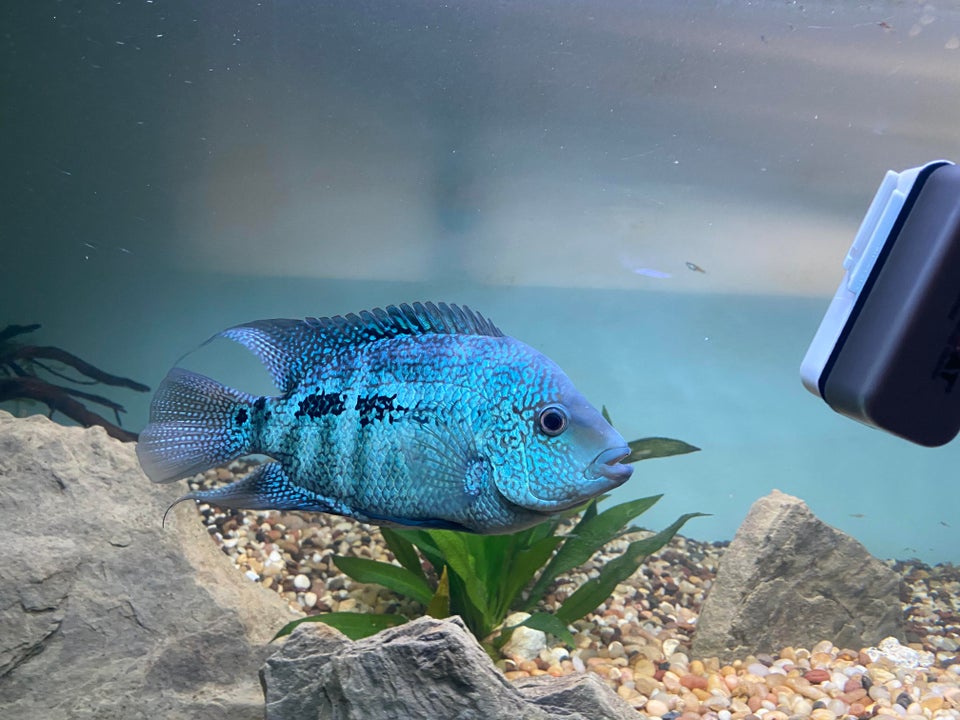
Due to the high adaptability of the fish in diverse water conditions keeping it in the tank isn’t much of a deal even for a beginner. The major issue with the fish is its rather high aggressive nature meaning that if you wish to keep it in the same tank with different fish species you need to be careful.
Due to the high aggressive nature of the fish, it has a tendency to turn any nice tank it is kept in to a complete mess!
Now, let us take a look into some of the basic tank requirements that will help you get started with the fish:
- Because the fish grows big even under captive condition a tank that can be able to hold at least 44 gallons of water of more is advised. Remember 44 gallons of water is only ideal for a single fish so that if you are planning to keep more, you will need a bigger tank! Of course you can keep the fish in smaller tanks but they will not grow sizes they ought to.
- The tank temperature should be regulated within the ranges of 24-26°C.
- As for the pH of the water even though it has the capacity to adjust to hard water just ensure the pH is between 6.0-8.0.
- Also ensure that the filtration of the tank is well taken care of due to the messy nature of the fish. This will somehow help keep the water quality better.
- Always renew the tank water on a regular basis because the fish is the kind that will leave behind lots of organic waste after every meal.
- At the bottom of the tank put a substrate layer that is thick as this will help to withstand the digging activities of the fish. Better use gravel or sand at the bottom of the tank.
- It is not a good idea to place live plants in the tank because the fish may feed on them.
Water Parameters for Texas Cichlid
Water Temperature
Texas Cichlids prefer warm water, in addition to being freshwater fish. This species prefers water temperatures between 71.5- and 77-degrees Fahrenheit. As a result, you may have to include a suitable heater in their tank arrangement.
Ph Level
Texas Cichlids require neutral or almost neutral tanks, with a pH of 6.5 to 8. To complement this pH, the water hardness should range from 8 to 15 dGH. In Texas Cichlids’ tank, a moderate water flow will also be beneficial.
Feeding Texas Cichlid
It is an omnivorous fish and thus feeds on both plants and other small animals thus feeding it is not complicated. You can feed it pellet feeds that are of good quality. Better still you can feed the fish live food such as brine shrimp and well as frozen food. Just ensure that you remove any leftover live food particles from the tank to avoid the possibility of bacteria developing in the tank.
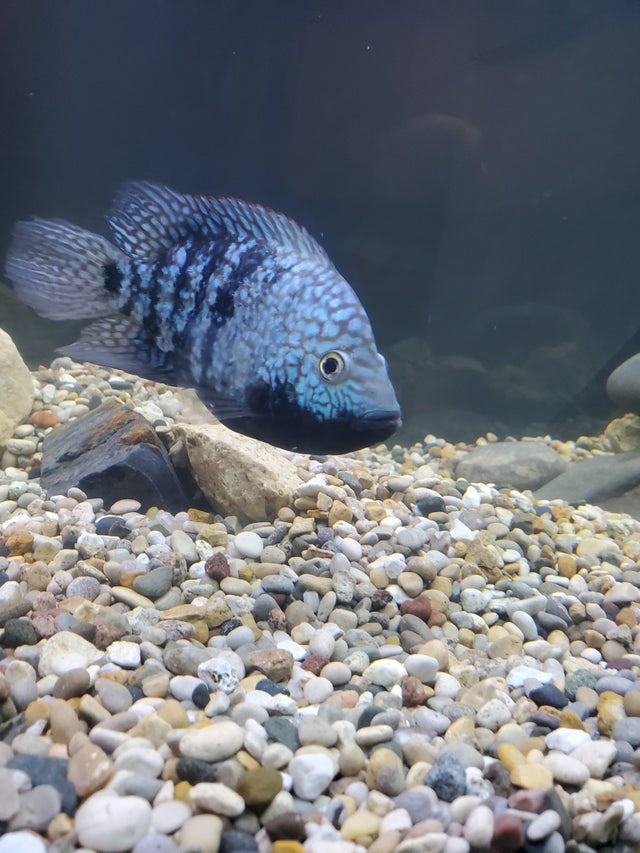
Best Diet for Texas Cichlids
Like any other living thing, Texas Cichlids’ nutrition and eating habits are critical. The food you feed them and how effectively you manage their diet will greatly impact their general health and growth. This is also an essential part of the Texas Cichlid care instruction.
Texas Cichlids aren’t picky eaters, which is one of the reasons they’re so easy to keep in a tank. They eat both plants and animals since they are omnivorous. They eat anything they can find in their natural habitat, including smaller fish, in the wild.
Texas Cichlids are known to be voracious eaters. As a result, their nutrition and feeding schedule are entirely dependent on you, as they will eat whatever you feed them, whenever you feed them.
You can give high-quality pellets to your Texas Cichlids. Live and frozen meals are also favorites. Blood worms, frozen shrimp, insects, crustaceans, and other items can be fed to them. Plant-based foods like spinach or lettuce can also be included. Because Texas Cichlids are hardy, they don’t require extra nutritional supplements.
How Often Should You Feed Texas Cichlids?
It is sufficient to feed them twice a day in a decent space to ensure their normal growth. Feeding juveniles three times a day can help guarantee that their diet meets their body’s rapid growth needs.
To avoid the growth of bacteria, it’s preferable to get rid of all the leftovers from the tank. To avoid any negative consequences, you should not overfeed your fish.
Texas Cichlids Behavior and Temperament
Like many other species of the Cichlidae family, Texas Cichlids may be aggressive and territorial. If you plan to keep over one fish, you should bear this in mind while picking a tank size.
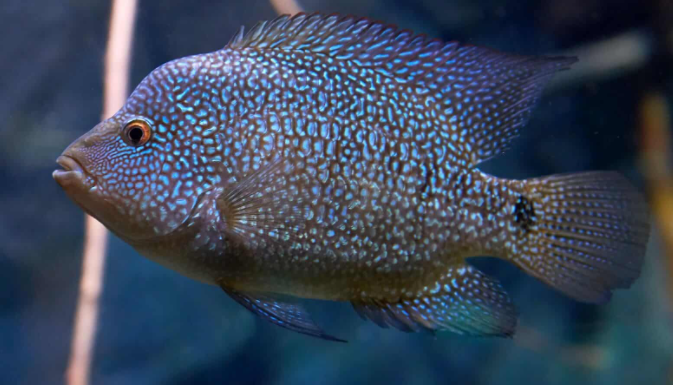
They are dominant in their habitat because of their aggressiveness and territoriality. Other fish, especially smaller fish, are frequently bullied and eaten by Texas Cichlids. This disposition also causes them to be picky when tank mates.
Because Texas Cichlids are active swimmers, you’ll rarely see them hiding until something is wrong. They can dig substrates and shift gravel around since they are diggers. They’re also bad swimmers. So don’t be surprised if you see them ripping the plants in their aquarium to shreds.
Texas Cichlids, on the other hand, appear to be quite intelligent. They possess a way of identifying their owners and connecting with them. When it’s time to feed, you’ll notice them moving forward, and they have distinct reactions to certain occurrences.
Are Texas Cichlid Lone or Societal in Nature?
Cichlids from Texas are not schooling fish. They don’t get along with one other, much less with members of different species.
Texas Cichlids Tankmates
Texas Cichlids often live alone in the wild because of their unwelcoming, hostile, and territorial character.
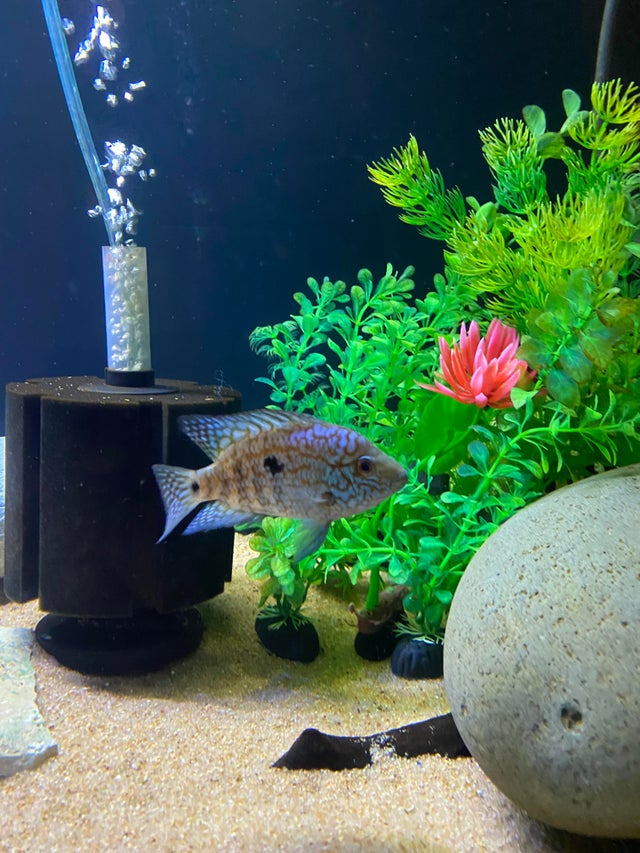
If sufficient care is not taken, keeping Texas Cichlids alongside other fish in the same tank can be devastating. Because members of this species are territorial and aggressive, you must examine several things before introducing additional fish into their area.
Tank size, adequate feeding, fish kind, and the temperament and behavior of the other fish are all aspects to consider.
You can keep the juveniles together with the other species securely, but the interaction becomes more problematic as they grow older. They discover how to attack other fish in their surroundings as they get older.
Ideal Tank Mates for Texas Cichlids
Texas Cichlids can have opposite behavior from some of the compatible species. Passive swimmers, as well as bottom tank dwellers, are among these species. However, tank size remains a significant effect.
- Plecos
- Giant Gouramis
- Scavenger Catfish
- Knifefish
- Tambaqui
Since they can fend for themselves and protect themselves against the bully conduct of Texas Cichlids, these species are relatively compatible. Giant Gouramis, for example, have a similar size, making it impossible for them to get bullied.
It’s easier to keep Texas Cichlids of the same species together. All you require is a tank with adequate area to allow for individual activity with minimal or no disturbance.
Breeding Texas Cichlid
Texas cichlid is a kind of fish species that is not hard to breed and you can place a male and a female in the same tank. If everything goes fine, courtship will follow and the opposite sexes will flirt with each other. In an interesting occurrence you can easily see the male trying to flap the side part of the female body.
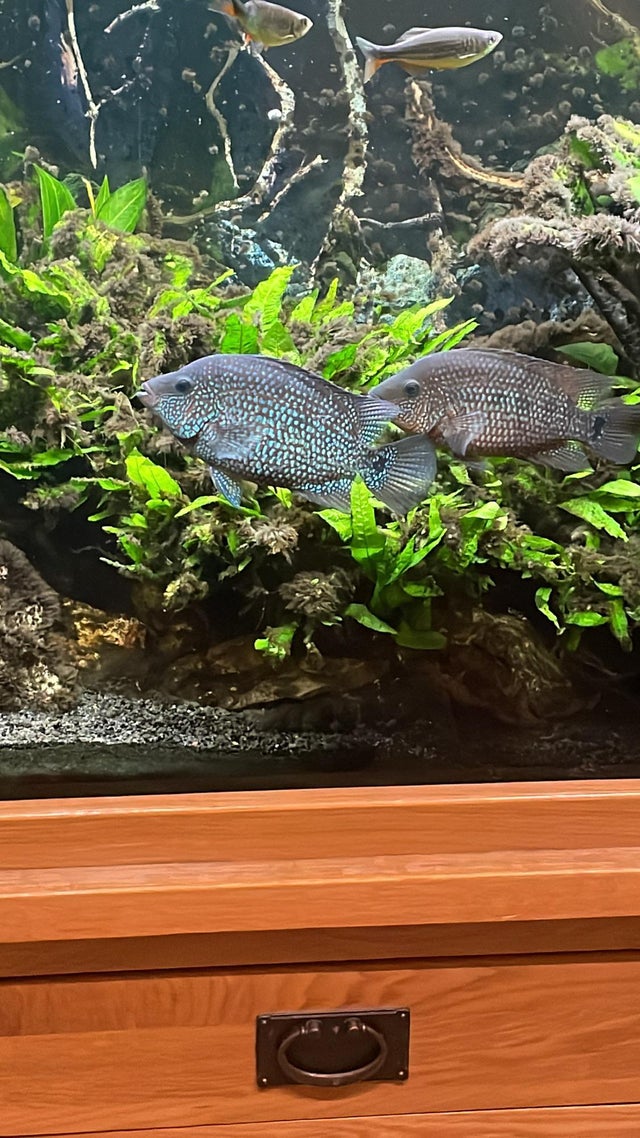
Once the fish are ready for the spawning process, they will clean an area usually the bottom part of the tank where there is sand. He female will then lay her eggs in the ‘cleaned area’ and eventually the male will fertilize the eggs successfully ending the spawning session.
The fertilized eggs will take up to 2 days for them to finally hatch into fry that you may then collect to a different tank. In about a week or so the juvenile fish will be ready to swim on their own and fend for themselves.
Texas Cichlid Breeding Level – Easy/Moderate
First and foremost, if you are fascinated by Texas Cichlid breeding and reproduction, you must reflect this in the tank set up as part of the Texas Cichlid care instructions. You should provide flat surfaces suitable for the fish to lay their eggs on.
Once Texas Cichlids reach a size of 2-4 inches, they can begin breeding and reproducing. You can hold a single female and male in the same tank to prepare them for breeding.
The courtship phase of the breeding process begins with the opposite sexes displaying wooing behavior. The male will constantly attempt to flap the female’s side body.
When the time comes for spawning, the female Texas Cichlid will arrange a suitable area to lay her eggs. The female will then lay her eggs on this surface, which the male will fertilize to bring their spawning session to a close.
Their eggs are about 2 mm in diameter and can generate 1000 eggs or more in a single spawning session. Within 2-3 days, the fertilized eggs will hatch into fry, which you may collect and place in a separate aquarium. Within 2-3 weeks, this fry can mature into self-sufficient juvenile Texas Cichlids.
Texas Cichlid Sexual Dimorphism?
Differentiating the female and male sexes of Texas Cichlids is a common problem. First, notice the color differences between female and male members of this species.
In comparison to female Texas Cichlids, males have more vibrant colors. They also grow to be significantly larger than females.
Male Texas Cichlids will also grow a pronounced cranial bump. These features can serve two purposes. It can assist you in telling the difference between males and how long a male Cichlid has lived for a few reasons.
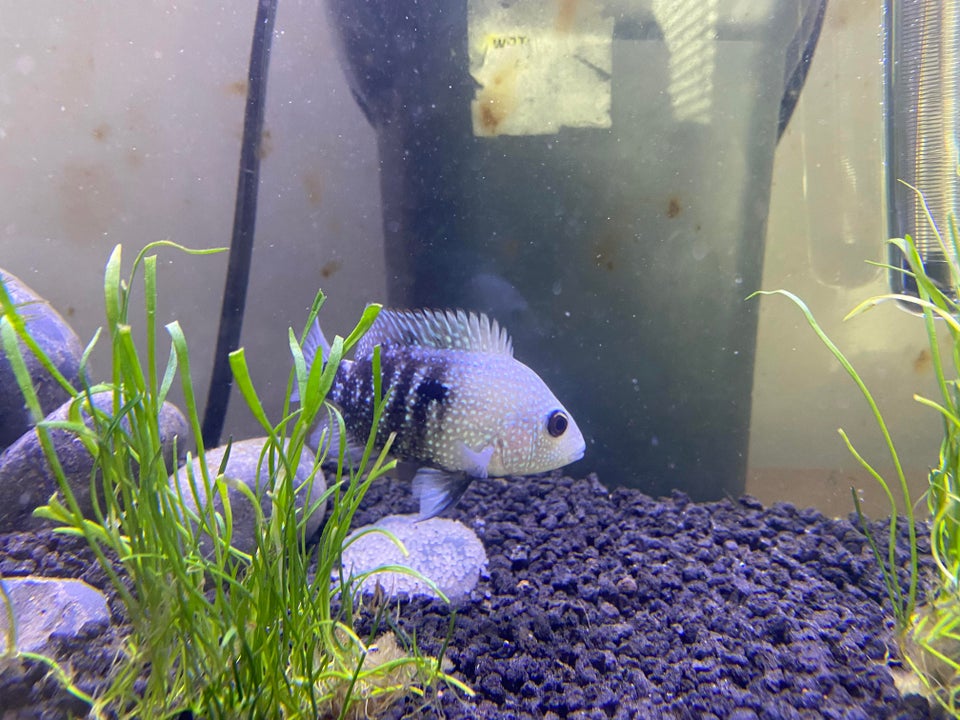
Texas Cichlids Common Diseases and Their Treatment
In contrast to other species, the Texas cichlid, Herichthys cyanoguttatus, is a resilient fish. Like many other large cichlid species, Texas cichlids are susceptible to ich and HLLE (hole-in-the-head disease).
Ich
Most tropical and cold-water tanks have the parasite, but it doesn’t cause a problem until a fish is compromised by disease, bad water conditions, or an improper diet.
The Ich parasite adheres to the fish’s skin, fins, and gills, causing a rash of some tiny white spots, and therefore the disease’s popular name, White Spot Disease. In reaction to the parasite’s discomfort, infected fish flick against aquarium objects and scratch their bodies on the substrate.
Fortunately, Ich can be readily treated by heating the water to 86 degrees Fahrenheit for 3 days and then treating it with over-the-counter medication.
Hole-In-The-Head Disease (HLLE)
Poor water quality and an unbalanced diet are the most common causes of head sickness, also known as Hexamita.
Pits or “holes” appear on the head and face of affected fish, as well as lesions along the lateral line. If the situation is not addressed quickly, infection will develop, and the fish will die.
Begin by increasing the quality of the tank and treating it with antibiotics obtained from a decent fish store or your veterinarian. To avoid future difficulties, make sure the fish’s diet is appropriate and well-balanced.
Disease Prevention
Maintaining proper water quality, feeding the fish correctly, and quarantining any new species in an isolation tank for a minimum of 14 days before bringing them to your main aquarium can help avoid disease outbreaks in your tank.
Before adding any new decorations, substrate, or plants to your tank, ensure they are fully washed and sanitized.
FAQs
What Is the Lifespan of a Texas Cichlid?
The Texas cichlid lives for 10 to 15 years on average. Texas cichlids can survive up to 15 years in aquariums if properly cared for.
What Is the Status of Their Conservation?
Texas cichlid fish is classified as a species of Least Concern. Based on the population and distribution of the fish, they are not in danger of extinction.
What Is the Size of a Texas Cichlid?
These fish may grow to be 12 inches (30.48 cm) long, ten times the size of a goldfish!
Conclusion
Cichlids from Texas are the most common species, with bright colors and huge bodies. They behave aggressively and intimidate others. Texas cichlids aren’t picky eaters, and they’ll eat anything, including live items, including plants, and animals.
Cichlids from Texas are tough fish. As a result, they are more flexible with tank requirements, although you must stay within a respectable range.
Because of their attitude and habits, finding a tank mate for the Texas Cichlids species can be difficult. However, important factors such as tank size, the size of other fish, as well as feeding habits might assist you in making the best decision.
[ad_2]
Source link
